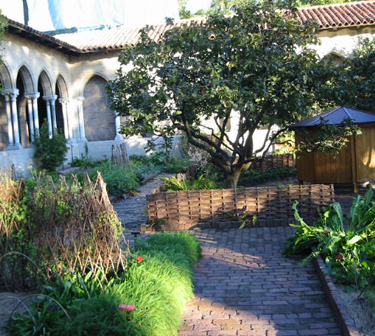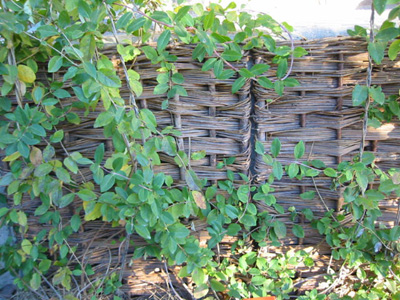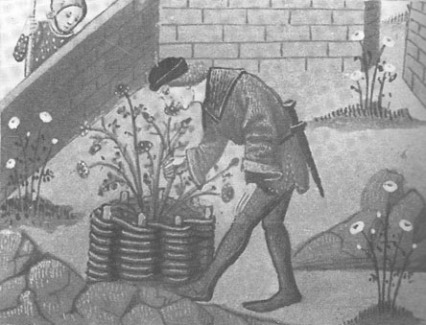The Cloisters, at the northern tip of Manhattan, on a hill overlooking the Hudson River, is not a church or a monastery but a branch of the Metropolitan Museum of Art (“the Met”) devoted to the art and architecture of the European Middle Ages.
In 1925, John D. Rockefeller, Jr., donated funds to the Met for the purchase of George Grey Barnard’s collection of medieval art, which became the core of the Cloisters’ collection. Then, in 1935, Mr. Rockefeller gave Fort Tryon Park to New York City, reserving the northern hilltop as the future site of the Cloisters. And in the 1930s, he donated land on the New Jersey side of the Hudson River to the Palisades Interstate Park Commission, to ensure that the Cloisters’ beautiful views would be preserved. Quite a gift.
Today the Cloisters’ collection comprises more than 5,000 works of art, mostly from the 12th to the 15th centuries — a profusion of illuminated manuscripts, stained glass, ivory carvings, paintings, wood sculptures, and, of course, the incomparable Hunt of the Unicorn and Nine Heroes tapestries. Both sets of tapestries were gifts from, yes, John D. Rockefeller, Jr.
Maybe it is because those magnificent weavings are so well known and well loved that I chose the modest handwoven wattle enclosure in the Bonnefont Cloister garden as this week’s featured weave (see it at the top of the page around the quince tree, and in a close-up below). The Bonnefont Cloister garden is one of three gardens at the Cloisters that were planted according to horticultural information gathered from medieval sources, including tapestries. Look, for example, at the amazing number of identifiable — and botanically correct — plants that were woven into The Unicorn in Captivity (shown above). If you’re interested, see The Flora of the Unicorn Tapestries, by Alexander and Woodward, an inexpensive booklet available on Amazon.
European wattle work dates back to before the 12th century. Mother Earth News defines wattle as the art of weaving flexible green sapling wood between upright posts. Their excellent article gives great information for DIYers, but (as you can see from Lynn Karlin’s photo at the top of that article), while making it yourself is economical and may be satisfying, the structures produced by weaving sticks and suckers just aren’t as rustically beautiful as the ones in the Cloisters’ herb garden. I was curious about who made those fences, so I posted a question on the Cloisters’ blog and got a detailed response from Deirdre Larkin, the Cloisters’ Associate Managing Horticulturist. I thought her letter was so interesting and informative that I asked her permission to reprint it here, and she graciously agreed:
Wattle fencing made from willow or hazel was often used in medieval gardens, and appears in many garden representations. The wattle in Bonnefont Cloister is woven from willow, and was commissioned for The Cloisters from English Hurdle in Somerset, England: http://www.hurdle.co.uk. The wattle panels at the center of the garden, underneath the quince trees, were installed in spring of 2007.
We have gotten willow fencing from this company for a good many years now. We often have inquiries from the public as to whether there is an American distributor for English Hurdle, but there is none at this time to my knowledge, although it is a very attractive and well-made product. This is probably because it is not cost-efficient to import it for resale, because of the following factors: It is heavy, and the shipping charges are significant. It must be inspected by U.S. Customs on arrival because it is made from wood, and could be a source of insect infestation or plant disease. it must be replaced every four or five years, as it does break down. (In the Middle Ages, willow was an important renewable resource, and there was plenty of cheap labor at hand.)
Once we have custom-ordered our willow fences, and they have been shipped, a customs broker acts as the Museum’s agent and sees to the delivery.
It is now possible to buy a much cheaper willow wattle fencing made in China, in various sizes, and this is available in garden centers and online at websites like www.gardensupply.com.
There are American distributors for the Chinese wattle, but I have to admit that it is not as handsome or as durable a product, and we don’t use it in the gardens here.
Deirdre Larkin posts on the Met/Cloisters’ blog, The Medieval Garden Enclosed. There you can find fascinating bits of information about the area where medieval art, gardening, and the history of the Middle Ages meet, along with gorgeous photographs.
Coincidentally, I just read in the NY Guild of Handweavers’ newsletter that several of my fellow Guild members will participate in the 2009 Medieval Festival at Fort Tryon Park, Sunday, Oct. 4. They will demonstrate weaving and spinning in period costumes created by Desirée Koslin, a medieval art historian and a Guild member. For more information about the Festival, click here. Admission is free.



